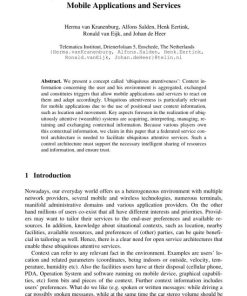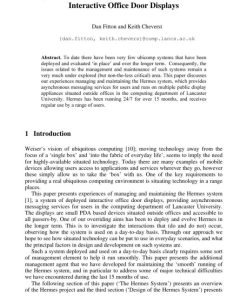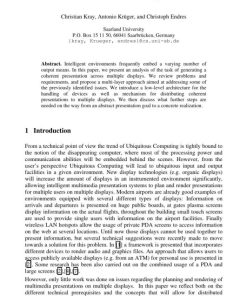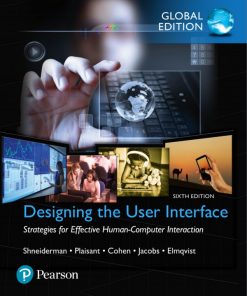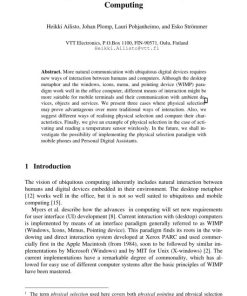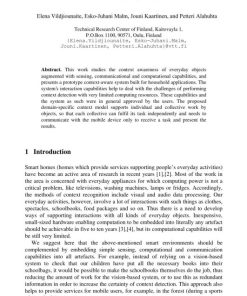Lino the User Interface Robot 1st edition by Ben Krose, Josep Porta, Albert van Breemen, Ko Crucq, Marnix Nuttin, Eric Demeester ISBN 3540204183 9783540204183
$50.00 Original price was: $50.00.$25.00Current price is: $25.00.
Authors:Ben J.A. Kröse, Josep M. Porta, Albert J.N. van Breemen, Ko Crucq, Marnix Nuttin; Eric Demeester , Tags:Ambient Intelligence , Author sort:Ben J.A. Kröse, Josep M. Porta, Albert J.N. van Breemen, Ko Crucq, Marnix Nuttin & Demeester, Eric , Languages:Languages:eng , Published:Published:Sep 2003
Lino, the User-Interface Robot 1st edition by Ben J. A. Kröse, Josep M. Porta, Albert J. N. van Breemen, Ko Crucq, Marnix Nuttin, Eric Demeester – Ebook PDF Instant Download/Delivery. 3540204183, 978-3540204183
Full download Lino, the User-Interface Robot 1st Edition after payment
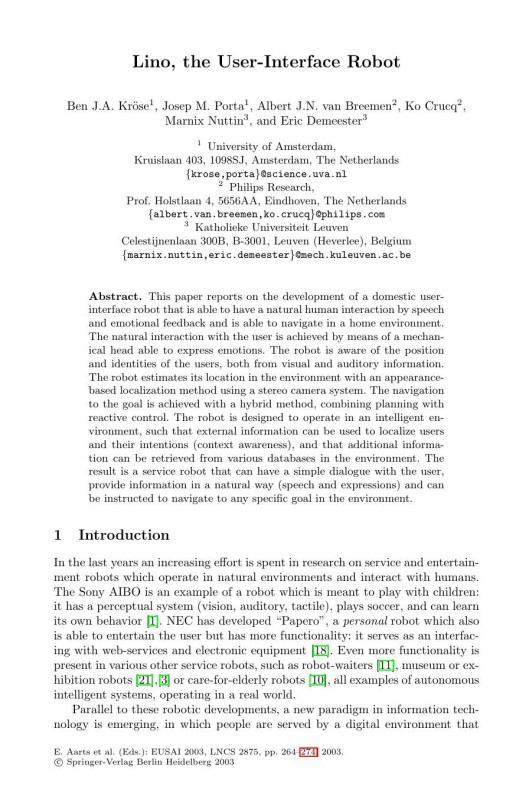
Product details:
ISBN 10: 3540204183
ISBN 13: 978-3540204183
Author: Ben J. A. Kröse, Josep M. Porta, Albert J. N. van Breemen, Ko Crucq, Marnix Nuttin, Eric Demeester
This paper reports on the development of a domestic user-interface robot that is able to have a natural human interaction by speech and emotional feedback and is able to navigate in a home environment. The natural interaction with the user is achieved by means of a mechanical head able to express emotions. The robot is aware of the position and identities of the users, both from visual and auditory information. The robot estimates its location in the environment with an appearance-based localization method using a stereo camera system. The navigation to the goal is achieved with a hybrid method, combining planning with reactive control. The robot is designed to operate in an intelligent environment, such that external information can be used to localize users and their intentions (context awareness), and that additional information can be retrieved from various databases in the environment. The result is a service robot that can have a simple dialogue with the user, provide information in a natural way (speech and expressions) and can be instructed to navigate to any specific goal in the environment.
Lino, the User-Interface Robot 1st Table of contents:
-
Introduction
- 1.1 Background and Motivation
- 1.2 Overview of Lino, the User-Interface Robot
- 1.3 Objectives of the Paper
- 1.4 Scope and Contributions
- 1.5 Paper Structure
-
Related Work
- 2.1 User-Interface Robots and Automation
- 2.2 Human-Robot Interaction (HRI) in UI Design
- 2.3 Existing User-Interface Robots and Technologies
- 2.4 Applications of Robots in User Experience (UX) Design
- 2.5 Review of Adaptive and Assistive Robot Interfaces
-
Design and Architecture of Lino
- 3.1 Robot Hardware Components
- 3.1.1 Sensors and Actuators
- 3.1.2 Mobility and Interaction Mechanisms
- 3.1.3 Design for Ergonomics and Accessibility
- 3.2 Software Architecture
- 3.2.1 Control Systems
- 3.2.2 Artificial Intelligence (AI) Integration
- 3.2.3 Communication Protocols and User Interface
- 3.3 Interaction Modalities
- 3.3.1 Gesture Recognition and Speech Interaction
- 3.3.2 Visual Feedback and Displays
- 3.3.3 Haptic and Auditory Feedback
- 3.1 Robot Hardware Components
-
User Interaction with Lino
- 4.1 User Interaction Models
- 4.2 Customizable User Interfaces
- 4.3 Contextual Awareness and Adaptivity
- 4.4 Multimodal Communication with Users
- 4.5 Personalization and User Profiles
- 4.6 User Feedback and Experience
- 4.7 Handling Errors and Misunderstandings
-
Applications and Use Cases
- 5.1 Lino in Assistive Technology
- 5.1.1 Helping People with Disabilities
- 5.1.2 Enhancing Accessibility in Digital Interfaces
- 5.2 Lino in Customer Support and Service
- 5.2.1 In Retail and Public Spaces
- 5.2.2 Enhancing the In-Store Experience
- 5.3 Lino in Education and Training
- 5.3.1 Educational Interfaces for Children
- 5.3.2 Interactive Learning Environments
- 5.4 Lino in Healthcare
- 5.4.1 Patient Interaction and Information Delivery
- 5.4.2 Assisting with Medical Procedures and Documentation
- 5.5 Lino in Smart Homes and IoT Environments
- 5.5.1 Integration with Smart Devices
- 5.5.2 Home Automation and User Assistance
- 5.1 Lino in Assistive Technology
-
Challenges and Limitations
- 6.1 Technical Challenges in Robot Design and AI Integration
- 6.2 Limitations in Understanding Complex User Intent
- 6.3 Balancing Autonomy and Human Control
- 6.4 Privacy and Security Concerns
- 6.5 Ethical Considerations in Robot-Assisted Interfaces
-
Evaluation of Lino’s Performance
- 7.1 Metrics for Assessing User Experience
- 7.2 Pilot Studies and User Trials
- 7.3 Feedback from Test Groups
- 7.4 Comparative Analysis with Other UI Robots
- 7.5 Key Findings and Insights from Evaluations
-
Future Directions
- 8.1 Advancements in Artificial Intelligence and Machine Learning
- 8.2 Expanding Lino’s Capabilities
- 8.2.1 Multilingual and Cross-Cultural Adaptation
- 8.2.2 Expanding Gesture and Speech Recognition
- 8.3 Integration with Emerging Technologies (e.g., AR/VR, 5G)
- 8.4 Scalability and Deployment in Various Industries
- 8.5 Long-Term Sustainability and Maintenance
-
Conclusion
- 9.1 Summary of Contributions
- 9.2 Reflection on Lino’s Impact on User Interface Design
- 9.3 Future Prospects for User-Interface Robots
- 9.4 Final Remarks
People also search for Lino, the User-Interface Robot 1st:
linorobot2 hardware
a robot’s interface allows a user to
click link robot framework
robot framework click link href example
link irobot to alexa





